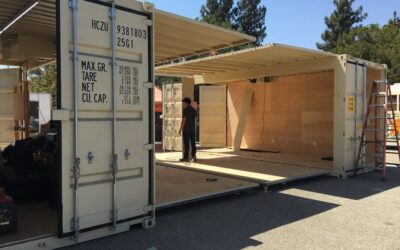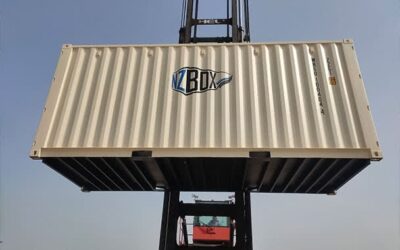While you may think that shipping containers are strong, air-tight structures, that’s not the case. While they may be strong, they’re definitely not airtight. In fact, nearly all shipping containers have small air vents built into them during manufacture.
These vents are designed to promote airflow during shipping and help protect the cargo inside. But, due to their size and the passive nature of the design, the airflow from these vents is minimal.
Do shipping containers need ventilation?
Because shipping containers travel long distances, the air vents installed during manufacturing are important for helping regulate the temperature and air quality inside them and help protect the cargo on its journey.
Generally, if you’re using a container for transportation or storage, these small vents are often adequate. But, if you’ve acquired a shipping container for storage, retail, or office space, it’s worth looking into additional venting options.
And, If you’re planning to use the shipping container for storage and the items you’re holding in it aren’t sensitive to temperature changes, keeping the ventilation as is will probably be fine. However, if you’re storing items you want to protect from the elements and temperature variations, installing additional ventilation is recommended.
Proper ventilation helps ensure there isn’t excess moisture retained in the container. This reduces the likelihood of mould and mildew growing, which can cause damage to items stored in the container. Excess moisture can also cause rust, so if you’re storing machinery or vehicles long-term, it’s worth making sure there’s sufficient ventilation.
If you’re planning on using the container as an office, or other space where you’ll be spending extended periods of time, you’ll want to install ventilation to prevent stale air and ensure the container stays at a comfortable temperature for you to work in.
What’s the best way to ventilate a shipping container?
Effective ventilation is dependent on circulating air in and out of the shipping container and replacing the warm, stale, humid air inside with fresh air from outside. There are several ways that you can do this. Here are some of the options available:
- Add more shipping grade vents. Adding more shipping grade vents to your shipping container automatically increases the amount of air that can move in and out of the container. Where you place these vents is also important. Placing them opposite each other, for example, allows for crosswinds, promoting better airflow through the container.
- Install a whirlybird. You can improve the airflow further by installing a whirlybird to the top of the container. These work by drawing stale air up and out of the container and allowing fresh air to be drawn in through the vents.
- Install a wall-mounted fan. If you need something more powerful, a wall-mounted fan may be a good option. Like whirlybirds, they draw stale air out of the container and allow fresh air to flow in. Wall-mounted fans are also a great option if you’re planning on stacking shipping containers.
The size of your container also influences the type of ventilation you choose, as well as the size and number of vents or fans you need to install. A singly whirlybird and smaller vents may be suitable for a smaller, 20ft shipping container, but if you have a larger 40ft shipping container, more fans and larger vents may be needed to provide adequate ventilation.
What else can I do to protect the items stored in a shipping container?
Once you’re satisfied with the level of ventilation in your container, and if you’re planning on storing items long- term, it’s worth installing some moisture absorber bags in your storage container. They will absorb excess moisture in the air and help keep the inside of the container dryer. This helps prevent the humidity level from getting to the ‘dew’ point and causing condensation, which will protect the items in the container from being damaged by moisture.
Moisture absorber bags are particularly helpful here in New Zealand, where we experience high humidity. They will also help during periods when even adequate ventilation won’t keep all the moisture out. These bags absorb up to 300% of their dry weight and 4-6 of these bags will keep a 20ft shipping container dry.
No matter what purpose you’re using your shipping container for, it’s worth checking that it’s ventilated properly. This will help ensure stored goods stay in the best condition possible if you’re using it for storage or transportation, or that it’s a pleasant environment to work in if you’re using it for retail or office space.
Need advice on ventilating a shipping container?
NZBOX has an excellent range of container ventilation options. Get in touch with our team today to discuss your requirements and get advice for your situation.
If you’d like to find out about the different types of shipping container available, or you want to hire or buy one, talk to the team at NZBOX today.
Frequently Asked Questions
Do shipping containers really need ventilation?
Yes, shipping containers need ventilation because while they are strong, they are not airtight, and without proper airflow, excess moisture can build up, leading to mould, mildew, and rust that could damage stored goods.
Are the standard vents in a shipping container enough?
The small vents built into shipping containers during manufacturing are usually adequate for transport and basic storage, but if you are storing sensitive items or converting your container into a workspace, you will likely need additional ventilation.
What are the best ways to ventilate a shipping container?
The most effective options for ventilating a shipping container include adding more shipping-grade vents, installing a whirlybird on the roof to draw out stale air, or fitting a wall-mounted fan for stronger airflow, especially if containers are stacked.
How do I choose the right ventilation option for my container?
The type of ventilation you need depends on the size of your container and how it will be used, with smaller 20ft containers often requiring fewer vents or a single whirlybird, while larger 40ft containers may need multiple fans or larger vents to ensure adequate airflow.
What else can I do to protect items inside a shipping container?
In addition to ventilation, you can use moisture absorber bags, which are highly effective in humid climates like New Zealand, as they prevent condensation and help keep stored items dry and free from moisture damage.









